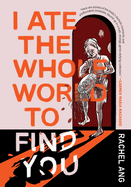
Australian artist/writer Rachel Ang's compelling I Ate the Whole World to Find You gathers five loosely interrelated stories exploring a young woman's evolving relationships--romantic, platonic, familial. Ang draws black-and-white panels of assorted sizes, including full pages, boxed inserts, symmetrical divisions of two, four, six, as if repeatedly imposing order on emotional experiences and difficult confrontations. Where Ang places their text bubbles--often outside the panels--seems to underscore the inevitable unpredictability of real-life conversations.
In "The Passenger," Jenny travels on a train with a couple with whom she is having trouble communicating; she turns "into some silent interior part of myself," berating herself for being "revolting... wholly unlovable." But as their failure to communicate devolves into a dreamscape, her rebuffed attempts to talk to her angry ex-partner make her realize, "I can't stay here. I gotta go."
A phone call from her cousin sends Jenny into memories of a shared past in "Your Shadow in the Dark," with utterly shattering revelations. In "Purity," pregnancy offers Jenny a chance to "start anew" with another soul: "a connection far deeper, wider, purer, than the limited frame of language." Communication beyond the womb, however, "is easily jammed by external frequencies."
Ang's narrative is textually minimal. Their expressive art builds layers of meaning not reliant on extensive words. "This is how I build a way out," for example, is an otherwise wordless, two-page how-to that Jenny must devise to create her own escape. "It's like no one knows what to do with women's bodies," a character comments. Step-by-step, panel-by-panel, amid complications and challenges, Ang enables Jenny to painfully, tenaciously, figure out her own self. --Terry Hong

